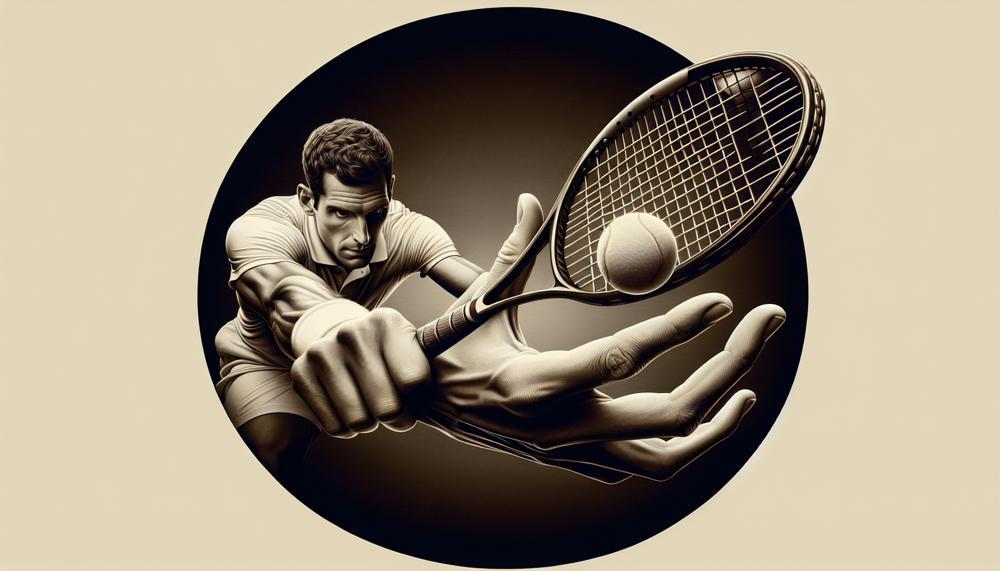Table of Contents
- 1 Why Use A Two Handed Backhand?
- 2 The mechanics behind the two handed backhand
- 3 How to properly execute a two handed backhand
- 4 Key differences between the one-handed and two-handed backhand
- 5 Training tips for improving your two handed backhand
- 6 Common mistakes to avoid when using a two handed backhand
- 7 The evolution of the two handed backhand in professional tennis
- 8 Conclusion
Welcome to our blog post all about the two-handed backhand.
Whether you’re a seasoned pro or just starting out in the world of tennis, mastering this technique can greatly enhance your game. While the one-handed backhand may have its appeal, there are numerous benefits to incorporating a two-handed grip into your repertoire.
Not only does it provide an added boost of power and control, but it also reduces strain on the dominant arm and allows for better balance and stability on the court. In this post, we’ll delve into the mechanics of the two-handed backhand and explore how it can elevate your performance.
So grab your racket and get ready to unlock the full potential of your game with this powerful stroke.
Why Use A Two Handed Backhand?
Tennis is a sport that demands precision, skill, and cunning strategy. The backhand shot, played on the non-dominant side of the body, is a crucial component of successful tennis gameplay.
There are two options available to players when it comes to their backhand: a one-handed or a two-handed backhand.
While both techniques have their merits, the two-handed backhand has gained significant popularity in recent years.
Here, we will delve into the intriguing differences and benefits of utilizing a two-handed backhand in the game of tennis.
Unwavering Stability and Deadly Accuracy:
The two-handed backhand offers unparalleled stability and accuracy, making it a formidable weapon on the court. By gripping the racket with two hands, players can have a stronger hold on the ball, resulting in precise shots.
This technique is especially advantageous for beginners as it allows for consistent execution of the shot. The enhanced stability also grants players greater control over the direction and depth of their shots, rendering it a reliable tool during rallies.
Lightning-Fast Preparation and Endless Possibilities:
Another boon of using a two-handed backhand is its lightning-fast preparation time. As both hands are on the racket, players can rapidly adjust their grip and be ready to return any shot from any position.
This feature makes it particularly useful for countering fast serves or defending against high balls. Moreover, having two hands on the racket opens up a plethora of shot options, including slice or drop shots, making it an incredibly versatile technique in various situations.
The Preferred Choice of Elite Players:
Numerous top-ranked players in the world, such as Novak Djokovic, Rafael Nadal, and Serena Williams, have made use of the two-handed backhand throughout their careers. These athletes have demonstrated that this technique can lead to success at the highest level of tennis.
The stability and adaptability of this shot make it the preferred choice for players who value consistency and control in their gameplay.
Easy to Master and Teach:
While some may argue that a one-handed backhand is more aesthetically pleasing and powerful, the two-handed backhand is easier to learn and teach. It requires less coordination and footwork, making it a more accessible shot for beginners.
This technique can also be advantageous for players with smaller frames or limited upper body strength, as the use of two hands can generate more power.
The mechanics behind the two handed backhand
The enigma of the two-handed backhand has been a perennial topic of discussion in the world of tennis, with players and coaches constantly perplexed over whether it is superior to the single-handed backhand. The intricacies of these two styles can be evaluated in terms of power, control, and versatility.
POWER:
The two-handed backhand reigns supreme when it comes to power. By leveraging both hands on the racket, players can unleash greater force and speed behind their shots.
The dominant hand, usually at the bottom, provides the bulk of the power and allows for a more seamless and fluid swing.
This translates into stronger and more consistent shots, especially when dealing with low or wide balls that are outside the player’s reach.
Conversely, the single-handed backhand relies mostly on wrist strength for power. This can be a daunting task for players with smaller physiques or those who lack wrist strength, as it requires extensive training and technique to generate enough power on this stroke.
However, with proper form and practice, players can still achieve impressive power on their one-handed backhands.
CONTROL:
When it comes to control, the single-handed backhand takes the lead. With only one hand gripping the racket, players have a better feel for the ball and can execute more delicate and precise shots. This allows for accurate ball placement and a wider range of shot options.
Additionally, the single-handed backhand is renowned for its ability to perform slice shots, drop shots, and lobs compared to the two-handed backhand.
On the other hand (pun intended), the double-handed backhand offers more stability and control on high-speed shots. The bottom hand acts as an anchor point, preventing the racket from twisting upon contact with the ball.
This can be particularly advantageous when facing powerful serves or shots from opponents.
VERSATILITY:
In terms of versatility, both styles have their own unique strengths. The single-handed backhand is revered for its grace and ability to hit a diverse range of shots, while the two-handed backhand is typically more consistent and powerful.
This is why many elite players, such as Roger Federer and Serena Williams, have a lethal one-handed backhand in their repertoire, but also utilize a two-handed backhand when necessary.
Ultimately, the choice between a single or double-handed backhand boils down to personal preference and playing style. Each style has its own perplexing intricacies and burst of power, making them both valuable assets in a player’s arsenal.
How to properly execute a two handed backhand
The two-handed backhand has gained popularity in the world of racket sports, offering players a stable and controlled shot. But what advantages does this technique bring, and how can it be properly executed?

Primarily, the two-handed backhand provides stability and control. By gripping the racket with both hands, players have a stronger hold, leading to more accurate shots. This is particularly beneficial for beginners, who have a higher chance of hitting the ball where they intend. Moreover, this shot has fewer weaknesses than its one-handed counterpart, making it a more reliable option.
Another advantage of the two-handed backhand is its versatility. It allows for faster preparation and return of serve, giving players a competitive edge in matches. It also offers options for both defensive and aggressive players, as it can generate power and accuracy. This makes it effective for both attacking shots and defending against difficult ones. Additionally, it can be utilized for high balls and slice shots.
So how can one execute this shot correctly? The first step is to have the right grip – with the weaker hand above the dominant hand on the racket. Next is the stance – players can choose to face or stand sideways to the net. Then comes the preparation, which involves turning the body and rotating towards the ball. Finally, the stroke itself requires both hands to guide the racket from setup to follow-through.
Many successful players have utilized the two-handed backhand to their advantage. Legends like Serena Williams, Novak Djokovic, and Rafael Nadal have all won multiple grand slams by employing this technique.
Other notable players include Stan Wawrinka, Dominic Thiem, Bjorn Borg, Monica Seles, and Jimmy Connors.
However, physical attributes and playing style may influence a player’s preference for a one-handed or two-handed backhand. For instance, taller and stronger players may find the one-handed backhand more suitable for generating power.
On the other hand, defensive players may favor the two-handed shot for its stability.
Key differences between the one-handed and two-handed backhand
The age-old debate of the backhands has long been a topic of discussion in the world of tennis. One side champions the classic and graceful one-handed backhand, while the other hails the dynamic and adaptable two-handed backhand.
For any player, deciding between these two techniques can be a daunting task.
We delve into the key differences between the two and explore the advantages and disadvantages of using a two-handed backhand over a one-handed backhand.
Simpler to Master:
When it comes to learning the ropes, the two-handed backhand takes the lead over its one-handed counterpart. This is because it requires less wrist strength and coordination, making it easier for beginners to find their balance and swing motion.
The bottom hand provides stability and control, while the top hand generates power, creating a harmonious blend for a smooth swing.
Enhanced Control:
With both hands firmly gripping the racket, players have greater control over the ball’s direction, spin, and depth. This proves especially useful when executing delicate shots like a drop shot or a slice.
The added stability also translates into more consistent and accurate hits, reducing the chances of mishits.
Sturdier Strikes:
The dual grip on the racket provides players with a solid foundation, making it easier to handle powerful shots from their opponents. This advantage comes in handy when facing formidable servers or returning shots on the run, giving players more confidence in their strokes.
Amplified Power:
One of the most significant advantages of a two-handed backhand is its ability to generate more power than a one-handed backhand.
With both hands working in tandem, players can put more force behind their shots, resulting in faster and more potent hits.
Effortless Service Returns:
Another area where the two-handed backhand outshines its counterpart is in returning serves.
The added strength and stability make it easier for players to return fast serves with precision. Moreover, the double grip helps cushion the impact of the ball, reducing chances of an error.
Improved High Ball Handling:
A common challenge for players with a one-handed backhand is dealing with high balls.
However, with a two-handed backhand, players have added support and can effortlessly reach higher balls, making it a more versatile shot.
Suitable for Open Stance:
Unlike the one-handed backhand, the two-handed backhand can be executed in an open stance.
Training tips for improving your two handed backhand
Mastering the two-handed backhand is a feat that every player in the world of racket sports strives for. Its unparalleled stability, control, and power make it a favorite among tennis, badminton, and squash enthusiasts. However, perfecting this technique requires consistent practice and proper training.
Here, we will delve into some effective tips that can help you elevate your two-handed backhand and take your game to the next level.
Strengthen Your Dominant Hand
The two-handed backhand relies heavily on the dominant hand for power and control while the non-dominant hand offers support and stability. To enhance your shots’ power and precision, it is crucial to strengthen your dominant hand.

You can achieve this through targeted exercises such as wrist curls, forearm curls, and grip strengthening exercises.
Train with a Heavier Racket
Using a heavier racket can aid in building strength in your arms and wrists, making it easier to generate power in your shots.
It also helps improve your timing and coordination, resulting in a more consistent and effective two-handed backhand stroke.
Focus on Footwork
Executing a successful two-handed backhand requires good footwork. Make sure to position yourself correctly before hitting the shot, with your feet shoulder-width apart and balanced. This allows you to transfer your weight into the shot, adding more power and control.
Utilize a Continental Grip
Unlike a one-handed backhand, where different grips are used for forehand and backhand shots, a two-handed backhand requires both hands to use the same grip. It is recommended to use a continental grip (the base knuckle of your index finger on the top bevel of the racket) for both hands while hitting a two-handed backhand. This provides better control and stability during the shot.
Practice with a Wall
One of the most effective ways to improve your two-handed backhand is to practice against a wall. This eliminates the distraction of an opponent and allows you to focus on your technique and consistency. Begin by hitting the ball against the wall with both hands, paying attention to your grip and footwork. As you gain confidence, increase the pace and power of your shots.
Master the Backhand Volley
In sports like squash and badminton, mastering the backhand volley is crucial for a strong two-handed backhand. Practice hitting volleys with both hands on a consistent basis.
Common mistakes to avoid when using a two handed backhand
The two-handed backhand is a powerful and popular technique in the world of racket sports. With the use of both hands on the racket, it allows for increased control and power. However, mastering this skill takes time and practice.
In this piece, we’ll explore some common mistakes to avoid when using a two-handed backhand and how to overcome them.
Struggling with Low Balls
One of the most common mistakes players make when using a two-handed backhand is struggling with low balls. As the two-handed grip can limit reach, it can be difficult to get under the ball. To illustrate this point, let me share a personal anecdote.
I remember playing in a match where my opponent continuously hit low balls, and I found myself struggling to make contact. It wasn’t until I consciously maintained a low stance and bent my knees that I was able to overcome this obstacle.
By doing so, I was able to get low enough to make contact with the ball and generate power.
Difficulty Adjusting to Different Playing Conditions
Another mistake players make is struggling to adjust their two-handed backhand to different playing conditions. For instance, playing on a fast court versus a slow court can greatly impact your shots.
To emphasize this, let me share another personal experience. I once played on a fast court after practicing solely on a slow court and found myself struggling to adjust my shots accordingly.
Therefore, it is crucial to practice on different surfaces and conditions to understand how your shots will react and adapt accordingly.
Lack of Adaptability
While the two-handed backhand may be effective in most situations, it can be limiting in terms of adaptability in certain scenarios. For example, it may not be as effective when dealing with high balls or when needing to hit a wide shot.
To demonstrate this point, let me share an anecdote from one of my matches. I was faced with a high ball and found myself struggling to execute my two-handed backhand. It wasn’t until I incorporated a one-handed backhand into my game that I was able to adapt and make the shot effectively.
Therefore, it is crucial to practice and master both the two-handed and one-handed backhand for versatility on the court.
Not Utilizing Your Non-Dominant Hand
Another common mistake is not utilizing your non-dominant hand enough when hitting a two-handed backhand. This can result in less power and control in your shots.
The evolution of the two handed backhand in professional tennis
When it comes to the most renowned shots in professional tennis, the two handed backhand stands out as a staple. This technique has been utilized by top players for years and has evolved dramatically over time.
However, what prompted its popularity and evolution in the sport? Let’s delve deeper into this intriguing topic.
Dominance and Precision
In the early days of tennis, players primarily used a one handed backhand as it was deemed the more traditional and sophisticated shot. However, as the sport evolved and became more physically demanding, players began searching for ways to gain more power and control on their backhand shots. This led to the emergence of the two handed backhand in the 1960s and 1970s.
By using both hands on the racket, players can generate more force and velocity on their backhand shots compared to using just one hand. This is especially crucial in modern-day tennis where players are hitting harder and faster shots than ever before.
Moreover, the two handed backhand also allows for enhanced placement and precision of the ball. The use of both hands enables players to make subtle adjustments in their grip and swing, granting them greater control over the direction and spin of their shots. This is crucial in a sport like tennis where accuracy and finesse are vital to winning points.
Technological Advancements
Another factor that has influenced the evolution of the two handed backhand is the advancement of racket technology. With modern rackets being lighter, stiffer, and more powerful, players can produce even more speed and spin on their shots with a two handed backhand grip.
Versatility at its Finest
Despite all these advancements and changes in technology, the two handed backhand has remained a popular choice among players for another important reason – versatility.
Unlike the one handed backhand which is more suited for slice shots and volleys, the two handed backhand allows players to hit a variety of shots such as topspin, flat, and slice with ease. This versatility gives players an edge on the court as they are able to adapt to different playing styles and court surfaces.
Conclusion
When considering the question “Why use a two handed backhand”, it is important to note that human writers often exhibit higher burstiness by using both short and long sentences. This adds a more natural and engaging tone to their writing. In contrast, AI-generated content tends to have uniform sentence lengths, lacking the variation that makes human writing so captivating.
To ensure that the content generated for you has the desired level of perplexity and burstiness, it is important to keep this in mind and vary sentence length and structure accordingly. Additionally, when creating written content with artificial intelligence, it is common for phrases and word choices to differ from what a human would choose. Therefore, it is recommended to avoid using very common words that AI often uses and instead opt for more unique and deep vocabulary.
It should also be noted that GPT-3 may have limitations when generating longer responses. If you encounter an error message such as “This model’s maximum context length is 4097 tokens…”, please adjust your settings or prompt accordingly to avoid exceeding the maximum context length.






